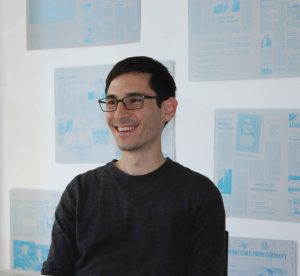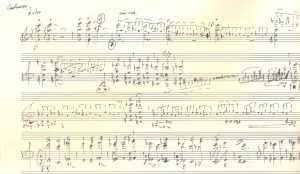Young Israeli composer Gilad Hochman finds inspiration in the dissonances he experiences in Berlin. Exploring the narrative of eternal migration, Hochman creates an impressive body of work ranging from pieces for solo instruments to chamber music and symphonies. We introduce the innovative composer in an exclusive interview. And find out why Hochman believes that “music is the closest thing to God.”…
A mandolin hovers through time and space, reluctant one moment, emphatic the next. Strings answer, alluring and disturbing at once. You sense the dynamics of motion. What kind of journey is this? Where will it take us? “Nedudim” – Wanderings – fantasia concertante for solo mandolin and string orchestra: In it, you hear thousands of years of changing places, of departing, searching, from one place to another, from one state of being to another. Forever questioning your whereabouts, your destination. This miracle of a chamber piece is the work of Gilad Hochman. Exploring the narrative of time and motion, of eternal migration, of belonging and alienation, are some of the themes of this young composer’s work, whom France 24 calls “a rising star in the classical music world.”
Gilad Hochman, 34, came to Berlin nine years ago. Born in Herzliya, his father hails from Odessa, his mother from Paris, her family being originally from North Africa. The East-European embraces the Sephardic tradition – in the European-Oriental mix that makes for Israel. All this you can hear in Gilad’s music.
Gilad is a wunderkind. He started composing at the age of nine. 15 years later, Gilad Hochman was awarded the Israeli Prime Minister’s Prize for Composition – honoring a “fascinating, original and colorful creator”. In your early twenties, where do you go from there? “It was wonderful to win the award – but also a little tricky”, remembers Hochman. “You know – as does the music landscape in the country – that you ‘are on a good level’”, as he charmingly puts it. Hochman decided to leave the path mapped out for him in Israel. “I needed a different perspective so I thought it would be best to go abroad for a while.” He turned down the offer of doing an American east-coast Ph.D. – and went to “check out Berlin instead”. What he found was a “spaceship, a bit like Tel Aviv … constantly work in progress and very different from the rest of the country”.
Obviously Hochman wanted to learn more about German culture – “the culture that made such tremendous contributions to classical music and at the same time the culture that brought about such utter and ruthless destruction”.
It seems that this tension, this “dissonance”, as the composer calls it, which he experiences in Berlin serves as an inspiration. The scope of Hochman’s work is impressive: chamber music, pieces for solo instruments like piano, (“Pia-No!”) marimba (“Berlin Beat”) or saxophone (“90 Seconds”), vocal music (“Night Winds” for soprano), to name a few, and pieces for symphony orchestra like “Suspended Reality”, a haunting exploration of the feeling of nothingness and utter stillness.
“Every time I start a new piece, I start from zero. I feel as if I have never composed anything before”, he says. Steeped in Jewish tradition, Gilad Hochman also takes Biblical themes like the binding of Isaac (“Akeda” for solo viola) or the Song of Songs (”Whom my Soul Loveth”) as a point of departure. “I am searching all the time. I dig deep inside of me to discover whatever there is, try to make it real and express it through my music.”
“I know that a piece works the moment when there is no sound, silence. When there is sound, people are with it, listening, some fall asleep – whichever way people absorb the music is fine by me – but the moment the music stops, usually at the end of the piece, but sometimes during the piece itself, there is this one instance of quiet intersubjective experience … almost like in a synagogue.” After all, says Hochman, music is the closest thing to God.


